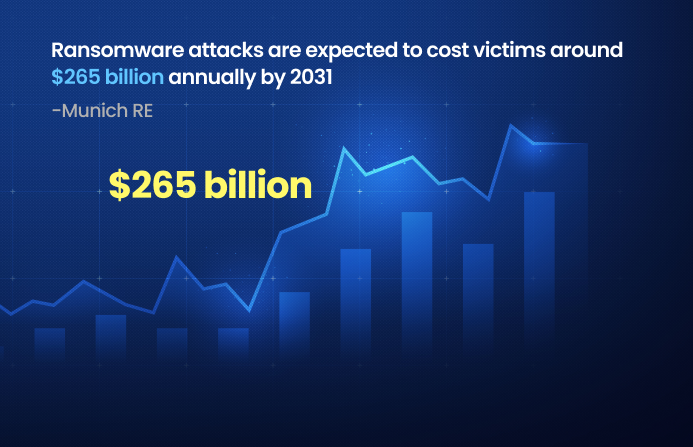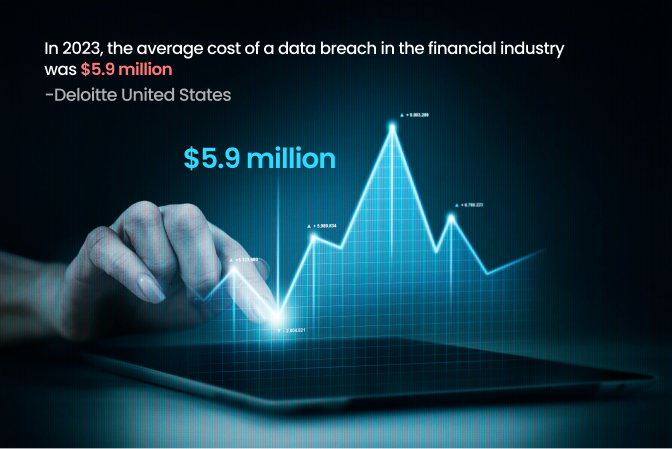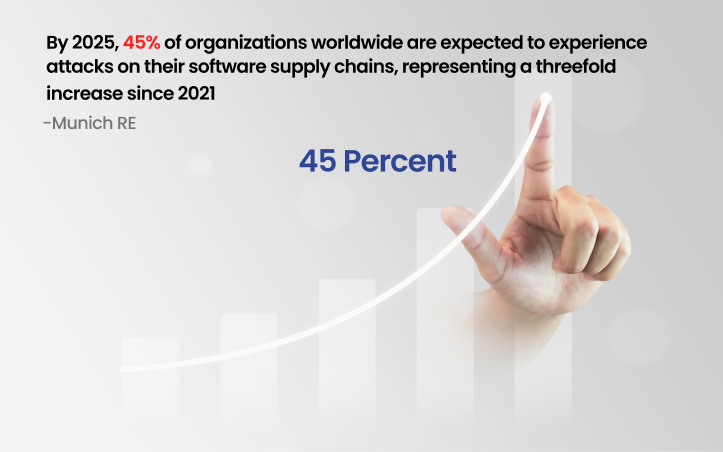“By 2025, 45% of organizations worldwide are expected to experience attacks on their software supply chains, highlighting the critical need for robust cybersecurity measures and insurance.” Currently, financial institutions face a multitude of cyber threats. With the increasing sophistication of cybercriminals, the need for robust cybersecurity measures and comprehensive cyber insurance has never been more critical. This detailed blog explores the various aspects of cyber insurance for financial institutions, covering the evolving cyber threat landscape, the role of cyber insurance, and best practices for mitigating risks.
Understanding Cyber Threats to Financial Institutions
1. Ransomware: A Growing Menace
Ransomware continues to be a major threat to financial institutions. These attacks involve encrypting an institution’s data and demanding a ransom for its release. The financial sector is particularly vulnerable due to the high value of the data they hold and the critical nature of their operations. Ransomware attacks are expected to cost victims around $265 billion annually by 2031 (Munich Re).

Key Aspects:
- Impact: Disrupts operations, causes financial losses, and damages reputation.
- Trends: Shift from data encryption to data destruction and theft.
- Prevention: Regular backups, employee training, and advanced security solutions.
Financial institutions must implement comprehensive security measures, including regular system backups, employee training to recognize phishing attempts, and advanced security solutions like endpoint detection and response (EDR) to mitigate the impact of ransomware attacks (Cyber Defense Magazine).
2. Data Breaches: The Cost of Inadequate Security
Data breaches involve unauthorized access to sensitive information, leading to financial and reputational damage. In 2023, the average cost of a data breach in the financial industry was $5.9 million (Deloitte United States). Financial institutions are prime targets due to the sensitive nature of the data they handle.

Key Aspects:
- Impact: Financial loss, legal consequences, and loss of customer trust.
- Prevention: Strong access controls, encryption, and regular security audits.
To protect against data breaches, financial institutions should implement strong access controls, encrypt sensitive data, and conduct regular security audits to identify and address vulnerabilities. These measures help minimize the risk of unauthorized access and ensure compliance with regulatory requirements.
3. Supply Chain Attacks: The Weakest Link
Supply chain attacks target third-party vendors to infiltrate financial institutions. By 2025, 45% of organizations worldwide are expected to experience attacks on their software supply chains, representing a threefold increase since 2021 (Munich Re).

Key Aspects:
- Impact: Disruption of services and potential data breaches.
- Prevention: Due diligence in vendor selection, continuous monitoring, and implementing security standards like SBOM (Software Bill of Materials).
Financial institutions must conduct thorough due diligence when selecting vendors, continuously monitor their security practices, and ensure that they adhere to industry standards. Implementing security standards like SBOM disclosure in license agreements can help mitigate the risks associated with supply chain attacks (ptsecurity.com) (Deloitte United States).
4. Social Engineering: Exploiting Human Vulnerabilities
Social engineering attacks manipulate individuals into divulging confidential information. These attacks rely on psychological manipulation and often target employees of financial institutions.
Key Aspects:
- Impact: Unauthorized access and data breaches.
- Prevention: Employee training, multi-factor authentication, and awareness programs.
Regular training and awareness programs can help employees recognize and respond to social engineering attempts. Multi-factor authentication adds an additional layer of security, making it more difficult for attackers to gain unauthorized access.
5. Mobile and Cloud-Based Threats
With the increasing use of mobile banking and cloud services, financial institutions face new security challenges. Mobile malware threats have grown by 80% on Android devices, and cloud-based attacks are becoming more prevalent due to the large volumes of sensitive data stored in the cloud (Cyber Defense Magazine).
Key Aspects:
- Impact: Data breaches, unauthorized access, and service disruptions.
- Prevention: Regular testing of mobile apps, implementing multi-factor authentication, data encryption, and choosing reliable cloud service providers.
Financial institutions should regularly test their mobile applications for vulnerabilities, implement multi-factor authentication, and choose cloud service providers with strong security track records. Ensuring compliance with standards like ISO-27001 and conducting regular penetration tests can further enhance security (Munich Re) (Cyber Defense Magazine).
The Role of Cyber Insurance
Cyber insurance provides financial protection against losses resulting from cyber incidents. It covers various aspects, including legal fees, notification costs, public relations expenses, and costs related to data recovery and business interruption.
1. Coverage Options
Cyber insurance policies vary widely, but key coverage areas include:
- First-party coverage: Covers direct losses to the insured, such as data breach response and business interruption.
- Third-party coverage: Covers claims against the insured by customers or partners affected by a cyber incident.
2. Customization and Adaptability
A robust cyber insurance policy should be tailored to the specific needs of the financial institution. It should cover a wide range of risks and be adaptable to the evolving threat landscape (AON). Customization ensures that the policy addresses the unique risks faced by the institution and provides adequate coverage for potential incidents.
3. Incident Response Services
Many cyber insurance policies include access to incident response services, which can be crucial in the aftermath of a cyberattack. These services help contain the breach, assess the damage, and initiate recovery efforts, minimizing downtime and mitigating further losses (AON) (Cyber Defense Magazine). Having a dedicated incident response team can significantly reduce the impact of a cyber incident and help the institution recover more quickly.
Best Practices for Financial Institutions
1. Investing in Cybersecurity Training
Continuous training for employees is essential in mitigating cyber risks. Well-trained staff can identify and respond to phishing attempts and other social engineering tactics, reducing the likelihood of successful attacks (Cyber Defense Magazine). Training programs should be regularly updated to cover the latest threats and include practical exercises to reinforce learning.
2. Implementing Advanced Security Technologies
Adopting machine-intelligent security systems can help detect and block suspicious activities. These systems use algorithms to recognize patterns and identify potential threats, providing an additional layer of security (Cyber Defense Magazine). Technologies like endpoint detection and response (EDR), network monitoring, and intrusion detection systems (IDS) are crucial for identifying and mitigating threats in real-time.
3. Conducting Regular Security Audits
Financial institutions should conduct regular security audits to identify and address vulnerabilities. This proactive approach helps ensure that security measures are up-to-date and effective against new threats (Deloitte United States). Audits should include both internal and external assessments, and the findings should be used to improve security policies and procedures.
4. Establishing Strong Vendor Management Practices
Given the risks associated with supply chain attacks, financial institutions should establish strong vendor management practices. This includes conducting thorough due diligence, continuous monitoring, and ensuring that vendors adhere to security standards. Regular assessments of vendor security practices and incorporating security requirements into contracts can help mitigate supply chain risks.
Emerging Trends and Future Outlook
1. Regulatory Compliance and Data Privacy
Regulatory compliance is a significant concern for financial institutions. Data privacy laws such as GDPR and CCPA require institutions to implement stringent security measures to protect customer data. Non-compliance can result in hefty fines and legal consequences.
Key Aspects:
- Impact: Financial penalties, legal actions, and reputational damage.
- Prevention: Implementing strong data protection measures, regular compliance audits, and staying updated with regulatory changes.
2. Artificial Intelligence and Machine Learning in Cybersecurity
The use of artificial intelligence (AI) and machine learning (ML) in cybersecurity is on the rise. These technologies can analyze large volumes of data to detect anomalies and identify potential threats in real-time.
Key Aspects:
- Impact: Enhanced threat detection and response capabilities.
- Implementation: Investing in AI and ML solutions, integrating them with existing security infrastructure, and ensuring continuous learning and improvement.
Securing the Future with Mitigata

As cyber threats continue to evolve, financial institutions must adopt a proactive approach to cybersecurity. Investing in comprehensive cyber insurance is a crucial step in managing risks and ensuring resilience in the face of attacks. At Mitigata, we specialize in providing tailored cyber insurance solutions that offer robust protection against a wide range of cyber threats. By partnering with us, financial institutions can enhance their cybersecurity posture and secure their future in a high-stakes environment.
Contact Mitigata today to learn more about how our cyber insurance solutions can help protect your institution from the ever-evolving landscape of cyber threats.
Also Read: Cyber Insurance for Fintech: Essential Protection.




